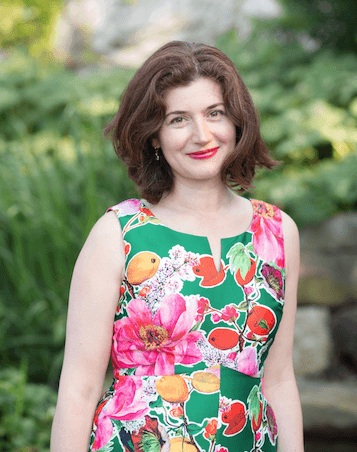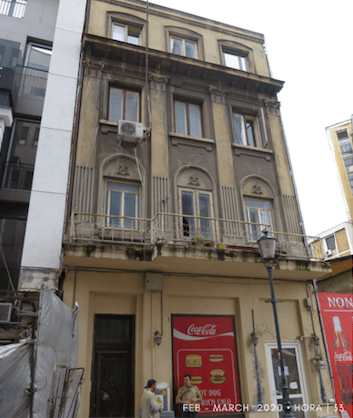
Emanuela Grama is an Associate Professor of Anthropology and History at Carnegie Mellon University. She is the author of the newly released Socialist Heritage: The Politics of Past and Place in Romania (Indiana, 2019).
Cristina Bejan: Professor Grama, what is your personal background and has that inspired you to tell the story of the Old Town of Bucharest in your recent book Socialist Heritage?
Emanuela Grama: I grew up in the city of Focsani, in Romania, during the late communist period. In the mid-1990s I went to Bucharest for college (I graduated from the University of Bucharest in 1998 with a major in Sociology [Bachelor’s Degree].) After I left for the US to pursue a PhD in Anthropology and History at the University of Michigan, I would still return to Bucharest almost every summer. I could see how much the Old Town was changing. I also noted how many politicians and ordinary people were constantly talking about this particular neighborhood in various registers, ranging from sharp criticism of its run-down buildings and streets to praise for its eclectic architecture.
I noticed that often many of these speakers were using the Old Town to talk about other topics, such as corruption, poverty and rising social polarization, a need to return to Europe, a nostalgia for a European past, etc. So, I decided to write a book that used Bucharest’s Old Town and its multiple political lives to better understand broader social and political phenomena happening in post-communist Romania, and the ways in which the legacy of the communist period still had an impact on the more recent social and political developments.
C.B: When did you begin this project and how did it evolve? It is my understanding that it started out as your PhD but grew to be the book? Please fill us in!
E.G: I never thought I would write a book about Bucharest. But in my last month of dissertation research, I found an anonymous letter in the archives. That letter became the nucleus of a chapter of my dissertation, which evolved into this book. My dissertation research initially brought me to Transylvania, where I studied the links between recent attempts for historic preservations and the ways in which the restoration of historic sites of ethnic significance came to play a major role for ethnic minorities to pursue claims of property restitutions. My dissertation was a comparative study, but my book focuses exclusively on the history of the Old Town as a way to discuss particular moments of the communist and post-communist periods in Romania, and the links between them.
C.B: What was the most surprising thing that you discovered while conducting your research for the book?
E.G: One of the most surprising discoveries is the controversy that emerged between some architects and archeologists concerning the Old Town—and that was sparked by the anonymous letter of denunciation that I found in the archives (mentioned above). In the 1950s, the architects who were working on transforming Bucharest into a modern socialist capital had initially thought that they could erase most of the urban fabric in the city center. However, they soon realized that they had neither the time, nor the resources or expertise to do so, so they chose to focus on the city outskirts. It was in these marginal locations that they could erect new neighborhoods for the rapidly growing urban population.
At the same time, these architects were not at all convinced that the Old Town represented anything of value. On the contrary, they viewed it as a liability. Their assessment of the Old Town was challenged though by some archaeologists, who found some of the ruins of a 16th century palace, which they promoted as a site of national importance for Romania’s history—and which eventually came to be fully reconstructed and opened as the museum of the Old Court.

This is how the fight between the architects and archaeologists began in early 1960s—and a part of this struggle over the meanings and value of the Old Town is captured by the letters exchanged among various institutions at that time, including the central government, the state division for urban planning, and the city museum of Bucharest.
C.B: You emphasize how the Old Town had an ethnically diverse population and how some architects – by using the historic architecture – tried to erase this ethnic heterogeneity via an architectural remodeling of some historic buildings according to an allegedly “National Romanian style.” Could you share a bit about communism’s role in shaping the Old Town and its people?
E.G: During the interwar period, many of the inhabitants of the Old Town were Jewish, but not only. A quick perusal through the phone books of the 1930s show that there were lots of businesses owned by people with Polish, Italian, Hungarian, German, Armenian, Greek, Albanian names—in addition to Romanian. I was not able to gain access to specific statistics about the change in the ethnic and social composition of the Old Town. However, I used other sources to gain some insight into these changes, such as, reports attached to urban planning studies, phone books, the list of the houses and apartments nationalized in Bucharest in 1948.
Many of the Romanian Jews left in early 1960s, and were forced to “donate” their apartments and houses to the communist state. This means that in their place, the state authorities brought new tenants, who were often people who lived on the margins of the city and wanted a better location, or first-generation of urbanites who moved to the city from the countryside in search for work (that is, until Bucharest became a “closed city” by 1970s).
Once the state authorities launched the urban “systematization,” the term that the politicians used as a justification to demolish a large part of the urban fabric of old Bucharest to make room for the new Civic Center, most of the people who began arriving in the Old Town were poorer and poorer. Some of them—but not all—were Roma. As one of my interviewees noted, most of these new tenants kept thinking that the bulldozers would come any day, so they were living in this limbo state, with their suitcases by the door. But the bulldozers never came into the Old Town, and I explain why in my book.
C.B: You employ beautiful photographs throughout the book. What is the story behind taking and collecting the photographs? Did you know that you were documenting Bucharest for this book as a photographer all along?

E.G: I love photography and I love taking photographs. However, in my book, in addition to the photos I took myself at different moments during my research trips to Bucharest, I also use some photos taken by others. For instance, the photos of the Old Town in the early 1990s, taken by Japanese photographer Norihiro Haruta, are wonderful visual resources for the reader to grasp how the Old Town looked then and how much it has changed within the last thirty years.
I am thrilled that the marketing team of the Indiana University Press accepted my first choice of the photo that appears on the book cover. That photo shows an old Trabant covered by ivy and abandoned in a courtyard of a 19th century house in downtown Bucharest. I took that photo in the summer of 2016, on Plantelor street in Bucharest. I was walking down that street when I saw an abandoned car in a courtyard, and I knew that I wanted this image to be on the book cover. The photo captures so beautifully many of the book’s themes.
The apartment building abutting the courtyard of the historic house symbolizes a socialist modernity that the communist state sought to launch partially via architectural changes. The abandoned Trabbie signals that that promise of alternative modernity partially failed. And the 19th century house evokes the ways in which the communist state exploited history and nationalism for their own benefit, to make themselves and the communist ideology more appealing to Romania’s citizens, esp. its ethnic majority.
C.B: What do you believe we Romanian-Americans can do to best contribute to Romania and the US, honor our roots and preserve our cultural heritage?
E.G: I don’t think of myself as a Romanian-American, but rather as a Romanian who has had the chance to live and work in the US. I grew up in Romania, and only recently did I become an American citizen. I believe that one of the most important things to do when you live outside the country of your birth is to try to engage in a critical form of nostalgia with that country—that is, if you chose to be nostalgic in the first place.
What I mean by “critical nostalgia” is to refuse to pay heed to a romanticized notion of a particular place, and instead to keep yourself informed about what is happening in that place here and now. I am trying—not necessarily that I succeed all the time—to keep in touch with colleagues and friends living in Romania. I also read the Romanian news on a regular basis, as well as new fiction and non-fiction books being published by up-and-coming Romanian writers.
When I visit Bucharest, generally during the summers when I don’t have teaching obligations, I try to immerse myself in the cultural life of the city. At the same time, I recognize that sometimes traveling is a privilege, and that many Romanian-Americans cannot travel so often. Perhaps they could seek alternative forms of cultural immersion, by ordering and sharing new books and cultural and political magazines published in Romania, and finding venues to talk to each other about what they are learning.
Tinerii luptă împotriva coronavirus cu o bicicletă
Susține cu o bicicletă tinerii din satul Cotiujenii Mari, care vor să vină în ajutorul persoanelor infectate sau care au nevoie de cumpărături și o mână de ajutor! În plus, sportul pe timp de pandemie este foarte necesar! https://www.facebook.com/donate/910332266086522/
Posted by Natalia Ghilascu on Sunday, May 10, 2020



